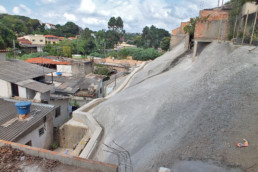By assessing the city against a quantified vulnerability index, Belo Horizonte has identified areas most in need of adaptation investment, protecting infrastructure and residents from climate change.
Completed in 2016, the Climate Change Vulnerability Assessment of Belo Horizonte has identified and quantified the city’s preparedness and ability to cope with the adverse effects of climate change, as the first step towards a climate adaptation plan. The assessment was based on a vulnerability index, made up of all climate change-related information available for the city, including landslides, floods, heat waves, and incidence of dengue fever, in the form of high-resolution georeferenced maps and basic statistics. The assessment identified four hotspots in the city with a vulnerability index in the 75th percentile, vulnerable to a range of climate change impacts. It also indicated that the area of such hotspots has increased over time and now covers 88 km2, or 27% of the city area.

The assessment was integrated with city-level urban planning, driving public and private investment in resilient urban infrastructure, public health, and adaptive measures. By gaining a sound and quantified understanding of vulnerability and providing guidelines for the prioritization of investments, the assessment will lay the groundwork for projects to improve the resilience of vulnerable areas and social groups, while improving the efficiency of public spending.
20% reduction in CO2 by 2030 as part of the city’s climate change policy, with which the assessment is integrated
The challenge
Belo Horizonte is experiencing an increased magnitude and frequency of extreme weather events and changes in precipitation and temperature patterns, causing landslides, floods, heat waves and dengue fever. Furthermore, exposure to climate change-related impacts is not distributed equally across the city. The Vulnerability Assessment has provided a foundation to bring adaptive measures into urban planning, prioritizing investments in order to mitigate climate change impacts and vulnerability inequality.
Co-benefits
Economic With advanced planning, the assessment expects to avoid future economic losses, such as damages to infrastructure and assets, loss of livelihoods, and emergency expenditures following extreme events.
Environmental The assessment provides evidence for the implementation of adaptation measures, such as investments in public transport, increase of tree coverage, ecological corridors, and green infrastructure.
Health The identification of hotspots vulnerable to dengue fever will enhance the effectiveness of actions aimed to control the expansion of the disease.
Social The project aims to provide decision-makers with evidence for developing public and private investment in low-income areas disproportionately affected by climate change-related impacts.
About Belo Horizonte
Belo Horizonte is the sixth largest city in Brazil, the thirteenth largest city in South America and the eighteenth largest city in the Americas. The metropolis is the third most populous metropolitan area in Brazil and the seventeenth most populous in the Americas and is the first planned modern city in Brazil. In planning the city, inspiration was sought in the urban planning of Washington, D.C. The city has employed notable programs in urban revitalization and food security, for which it has been awarded international accolades.


